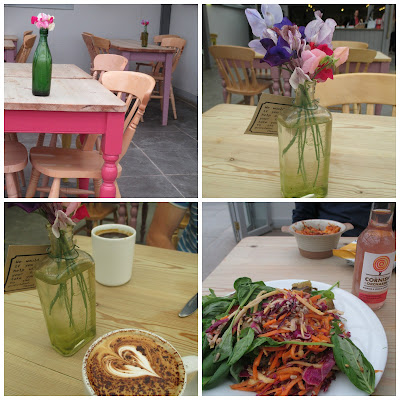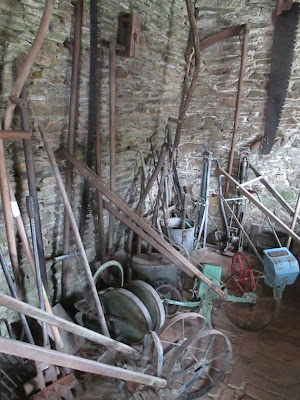Here I am again! I have lots to share with you this month and am making sure to fit it all in before term starts again and I'm back at work (I won't think about that yet).
One last bit of our Cornish holiday that I'd like to show you is a place I've long wanted to visit - the Lost Gardens of Heligan. We stopped there on our way home for a few hours and it was certainly worth a visit. Make yourself a cup of tea, pull up a chair, and I'll take you with me. There are lots of photos.
I'd expected a National Trust-style place with a big house, grounds, tearoom, etc. Delightful, and at times a little formulaic, but the reality was quite different. It was beautiful, grand, quite quirky and at times very poignant. The gardens, which were part of an estate and were attached to a large house, were 'lost' when most of the gardeners did not return from the First World War. The house was divided into flats and the gardens became overgrown and neglected. They were rediscovered in the 1990s and the restoration process began - it's come a long way since then.
The quirky Mud Giant greeted us as we entered the gardens. I love his orange and green crocosmia hair.
Too big a place for us to do in one visit, we started with the Woodland Ride and came across the famous sleeping Mud Maid.
I think she's rather lovely.
Further on the Grey Lady stands and is hard to make out in the trees. Can you see her outstretched arms?
This wonderful field was full of pale blue linseed flowers.
In complete contrast to this tranquil meadow was the fantastic Jungle Valley, with its own micro-climate which was crammed with tree ferns, gunneras, palms and all sorts of lush, shady vegetation.
The gunnera leaves were the biggest I've seen, and made us feel like Borrowers.
There were plenty of bananas too.
We followed a circular wooden walkway which took us high above the valley floor at times.
You can get an idea of the scale of the plants if you look at the person sitting at the side of the pond on the far right.
The few flowers were suitably exotic-looking.
I found the bananas' unfurling new leaves fascinating; they reminded me of rolled newspapers.
Everywhere there were patterns and textures: stripes, fans and lines in all shades of green.
And cool water reflecting the green-ness of the place.
There were stepping stones too. and a rope bridge, although the queue for it was enormous.
Another natural sculpture, this time made of charcoal.
We emerged from the jungle feeling hungry and made for the lovely cafe which sells delicious food made from the gardens' produce. I was very taken with the wooden furniture painted in shades of pink, lilac and yellow, and the sweet peas on every table.
After lunch a gentle wander took us past a few of the garden's feathery, furry and hairy inhabitants, like this sweet highland calf and an apple-stealing goose.
Pathways took us past hot, zingy herbaceous borders, full of primary colours.
On we walked under the Apple Arch to the walled vegetable and flower gardens.
The rows of vegetables were inter-planted with flowers. I have never seen so many snapdragons in one place!
Now I will confess that I took so many photos here that if I showed you them all we'd be here all day, so I have put them into mosaics to make them more 'user-friendly'. The squashes and courgettes made a very attractive display.
There was an impressive array of produce in beds and greenhouses, and a quietly busy army of gardeners working hard to tend the gardens.
So much fruitfulness!
Next came the flower gardens. They were just stunning.
I absolutely loved the helichrysums. There were many in shades from apricot to deep pink, and I resolved to grow some myself next year.
There were hot oranges and reds,
soft pinks,
cool blues and purples,
and even cooler whites.
The Melon Yard was interesting, with its neatly ordered rows of glass, and a Pineapple Pit too.
There's a memorial to the men who worked here and lost their lives in WW1. The Thunderbox was the gardener's loo and carefully preserved on its walls is their graffiti.
It's now registered with the Imperial War Museum as a 'living memorial'.
In another shed was a lovely collection of vintage tools.
I think they are a thing of beauty.
Well, that's the end of my trip to Heligan. It was a surprising and very beautiful place which I hope we'll return to before too long. Thank you for coming along and keeping me company.
See you soon x




























































Thank you for a beautiful visit. We visited Heligan last October and it was lovely to revisit in a different season. It certainly is a very magical place. B x
ReplyDeleteWow .....fabulous pics !!!!!
ReplyDeleteWhat a wonderful place to visit! The field of blue linseed flowers is beautiful, and the snapdragons. I am sure you had a lovely lunch in that cute cafe too!
ReplyDeleteThankyou for sharing your trip with us, brings back memories we went there last November when I won a 2 night break to a posh hotel, we spent an afternoon there although there wasn't as much to see that time of year we still enjoyed it xx
ReplyDeleteAmazing photos! Thank you for the tour - we visited many moons ago and it was lovely to remember it all. I love that crocosmia hair! xx
ReplyDeleteI was really pleased to see your photos as I would love to visit but it's such a long way to go! One day! So glad you had such a good trip x
ReplyDeleteThis is one for my bucket list and your photos have only served to increase my need to go!! Beautiful pictures/beautiful place :)
ReplyDeleteWonderful images, it is a long time ago since we visited this magical garden. Sarah x
ReplyDelete